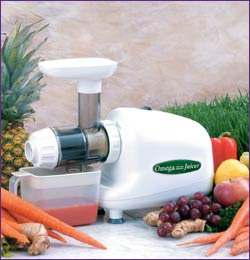"Hydrate or Die" - so it says on the side of my Camelbak water bottle. But recently I've been exploring the virtues of dehydrating - but this is fine and healthy, because I'm dehydrating my food, not myself.
I've spent the last two afternoons in the company of a new friend, Eva, who was introduced to me via a regular visitor to my website, Maui Bob, aka LJ Silver. I have to confess that my dehydrator had arrived over a month ago, before I left for New Zealand, but had sat in its cardboard box in a corner ever since. I would glance at it occasionally and wonder what the hell I was supposed to do with it.
Fortunately, Eva came to the rescue, and the mysterious box is now unpacked, and the dehydrator is whirring away busily in my kitchen. Over the last couple of days we have made granola, falafel, tamari sunflower snacks, nori crackers and flax crackers.
But why bother? you may be wondering. What does a dehydrator do that ordinary cooking doesn't?
Two reasons:
1. With the dehydrator I can create my own healthy meals for my rowing trip, rather than relying on expensive, low-grade, highly processed pre-packaged expedition foods.
2. Even while I am on dry land, the dehydrator opens up a whole realm of healthy new food options.
This is my understanding: before ingredients such as nuts, sunflower seeds, buckwheat and flax are incorporated into recipes, they are soaked overnight. This brings them to life, activating the enzymes that would eventually lead them to grow into sprouts and then plants. So instead of the nut being "dead" food, it is now alive.
Then, once you've mixed the live nuts or grains with all kinds of interesting ingredients and flavourings, the dehydrator "cooks" them into cookies/burgers/crackers at such a low temperature (110 degrees F) that the enzymes stay alive - compared with ordinary cooking which would kill them.
So the end product has all these health-giving enzymes that allow the body to digest the food more fully, gaining optimum nutrition from it.
More importantly as far as I am concerned, the end results are absolutely delicious. I am a sworn carnivore, but with veggie food like this, I could almost give up meat and not miss it. Uh oh - maybe I'm on my way to being a fully-fledged granola-head!
Here is my favourite recipe so far, although do get in touch if you have any other suggestions you would like to share.
And a P.S. One of the great things about the dehydrator is that I can incorporate the by-product from my juicer - the pulp from fruit and vegetables - into crackers, veggie "leathers", etc. So nothing goes to waste!
"Sunshine" burgers
1C walnuts, soaked overnight
1C pumpkin seeds, soaked overnight
7 sundried tomato halves, soaked for 4 hours (and save the liquid)
2/3 C mushroom stems and/or tops
2T Nama Shoyu sauce (a healthy form of soy sauce)
¼ t salt
1/3 C grated carrots
1t chilli powder
1t parsley
½ t garlic
3T olive oil
Combine in a food blender. Shape into patties. Dry in the dehydrator for as long as it takes - probably 12-16 hours.
|
|

No, not me. I wish! It's the title of Green People, sponsors of my skincare products and all-important sun protection.
The book includes many tips for natural body care, and also this startling statistic:
The average woman uses 15 personal care products a day. Up to 60% of the chemicals you put on your skin can end up in your bloodstream so you could be absorbing as much as 2kg (4.4lb) of man-made chemicals every year.
That's why I like using Green People's all-organic products. There is no point spending extra money to buy organic fruit, vegetables and meat if I then undo the good work by rubbing toxins into my skin. Especially given the large quantities of sun cream that I will need to use during my Pacific crossing, I want to know that I am not slowly poisoning myself!
It's refreshing to find a company that does not stint on the quality of their ingredients. At the risk of mentioning a possible competitor to Green People, I have just finished reading Body and Soul: Profits with Principles by Anita Roddick, the amazing and inspirational founder of The Body Shop. She saw her business as a way of effecting environmental, ethical and cultural change, inseparable from her own personal values. Shop windows became showcases for the issues that concerned her, and through their campaigns The Body Shop raised awareness and money for all kinds of good causes. Until her death in September last year she was a true pioneer of a different way of doing business - and the profitability of The Body Shop shows that this business paradigm actually works.
The book left me very inspired. It may not be the best-written, but she is passionate and persuasive and really made me believe that strong principles and a successful business are entirely compatible - as also demonstrated by Charlotte Vohtz and Green People. Recommended.
|
|

I've been buying some new toys - new FOOD-related toys, so I can capitalize on the healthy new eating habits I picked up during my New Year retreat. It's been a significant investment, but I'm investing in my health, and my health is precious beyond $$$.
The Juicer - Omega 8003
It's a bit slow, because everything has to be chopped into small pieces (I'd had visions of carrots disappearing down the chute at the speed of light!) but the upside is that it's a very efficient extractor of juice, so the residue is very dry and there's not much wastage. It's also very quiet so I don't disturb the neighbours.
Why is juicing a good idea? This information from my knowledgeable friend Martine:
"Juicing allows you access to the nutrients inside the plant's cells. Plants have thick walls we can't digest, so if the cell isn't squashed by chewing, you can't get the nutrients. There are bacteria in our colons that can digest the cell walls. They do, and we get gas, but the nutrients can't get in, because the colon comes after the small intestine, where all the nutrient absorption takes place. (Hence cows chewing cud and bunnies eating their poop). Since we don't recycle in either way, the nutrition is lost once it has passed through the small intestine.
So there you go, now juicing releases what is in the plant cells. This may be good, like in the case of nutrients, but may be not so good in case you get a big slug of monosaccharides (sugar high) or you get molecules you don't want, like some people don't want the phytoestrogens (I don't know why). Juicing means you get more calories per vegetable as well, which is good; it wastes less food overall.
This morning I had carrot, apple and ginger - a delicious and satisfying combination. It's a slow process - it took me about 15 mins to prep and juice the ingredients, but this made the 'meal' last longer and hence seem more satisfying.
I've decided that Sundays are going to be my regular juicing day. Today seemed a good day to start, as I rather fell off the no-sugar wagon yesterday (3 cookies - oops!) so this is helping to salve my conscience and limit the damage...
The Blender - Vita-Mix 5000
(I bought a factory-refurbished model, so it was cheaper)
I'm going to try a protein shake (The Ultimate Meal - a vegan, wholefood protein shake) for breakfast tomorrow.
The Dehydrator - Excalibur 9-tray
(bought from eBay)
On Tuesday Eva Boris, who was introduced to me via a regular visitor to this site, is coming round to show me how to use my new dehydrator to create some healthy foods and snacks - hopefully ones that I can take on my boat. That should be interesting - crackers made from sprouted seeds and the like.
And in keeping with my wholefoods theme, next week I've chosen a vegan restaurant, Cafe Gratitude in Berkeley, as the venue for a dinnertime meeting with my Pacific film producer. Check out the menu - even to a carnivore like me it looks fantastic! It might give you some ideas for things to try at home as well.
|
|

My lovely title sponsors, Brocade, bought me a new bicycle shortly before I left for New Zealand, but for some reason I had been putting off using it. I could claim that it was because the weather back then was wet and cold, but if I am honest I have to admit that it was because I was scared.
When I was a teenager, growing up in Cambridge, I used to cycle everywhere, but it is so true that if you don't keep expanding your comfort zone it doesn't just stay the same - it actually shrinks. So here I was, 25 years later, looking at my shiny new bike and thinking, "Maybe tomorrow..."
But today there was no excuse. The sun was shining and the roads were dry. The bike beckoned.
It helped that Sinead, my New Zealand tramping partner, had inspired me. She used to cycle to work in London - and that surely has to be a lot scarier than facing the Woodside traffic.
So I summoned my courage, strapped on my cycle helmet, and pedalled to the gym this morning. And of course it was great, because:
- It saved time. The half-hour round trip gave me a good workout, meaning I needed to spend half an hour less in the gym. I've replaced "dead" driving time with active exercise time.
- It saved money. The price of petrol has gone up about 30c since I was last in the US, so the less I use my car, the better.
- It saved the environment. By cycling instead of driving, I would save 2.25 tons of CO2 emissions in a year (if I was going to be living in Woodside for the entire year). Click here to calculate your own CO2 emissions.
- Plus, on a day like this, it is a real pleasure to be exercising outside instead of on a stationary bike in the gym. I got my daily dose of sunshine and Vitamin D simply by making a journey I needed to make anyway.
And hopefully, if I ride my bike every day, I might avoid humiliation the next time someone invites me along for a bike ride.
So if you've got a bicycle gathering dust in the garage, why not dig it out and take it for a spin. It will make you feel good - and you might even enjoy it!
|
|